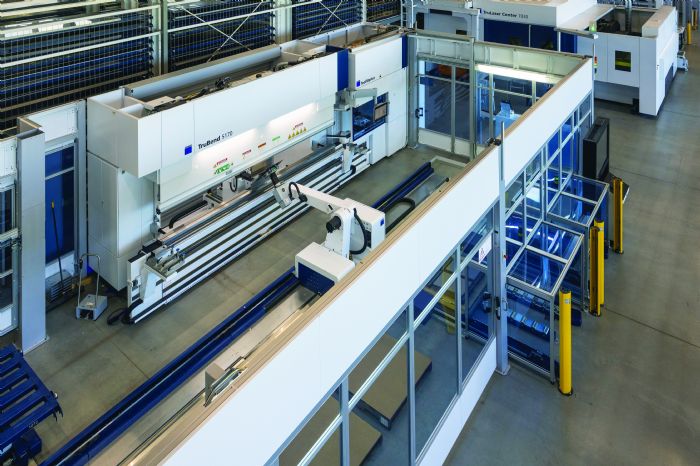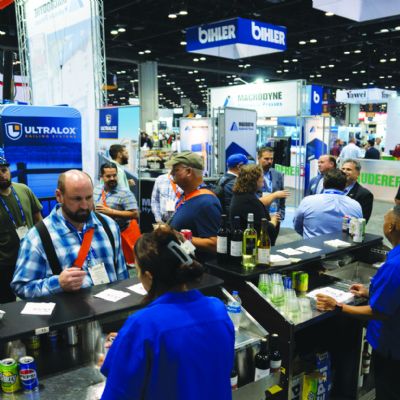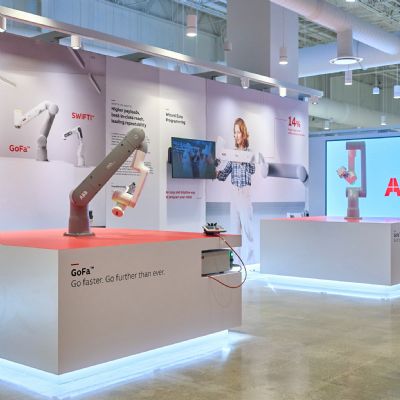So today, looking at the overall state of automation in metal forming, we find many work centers with ever smarter, more reliable primary production equipment and a significant presence of pick-and-place robotics, but a continued requirement for manual operators.
Labor Factors Driving Metal Forming Automation
 The impact of labor costs on global competitiveness and other labor-related factors—most notably the push for greater accuracy, repeatability and reliability, along with the need to ensure safety—will increase the return on investment (ROI) from automation.
The impact of labor costs on global competitiveness and other labor-related factors—most notably the push for greater accuracy, repeatability and reliability, along with the need to ensure safety—will increase the return on investment (ROI) from automation.
Labor Cost and Availability: Ask mid-tier metal formers who their competition is, and they almost always answer China. What they really mean: anywhere in the world with an abundant low-cost workforce. In many markets, labor has become more expensive and less available. Without operators there is no production, forcing many manufacturers to reduce or elongate production schedules. For instance, a metal fabricator recently notified customers of an across-the-board two-week increase in lead times, explicitly not due to machine capacity or supply-chain issues, but rather to labor shortages.
Accuracy, Repeatability and Reliability: The very essence of the value provided by primary production equipment is performing precision work in an accurate, reliable and repeatable fashion. Meanwhile, secondary processes depend on the reliability and skills of shop-floor operators. Do they always take care to perform the tasks correctly; are they always on task; do they come to work every day, and are they even available?
Applying well-designed automation to secondary operations brings a level of inherent predictability, reliability, repeatability and accuracy that can prove extremely difficult for humans to duplicate. For example, with one aluminum fabricator, automating laser cutting work centers had become necessary for ensuring product flow to downstream operations. Without this automation, failure to produce the necessary upstream parts could leave millions of dollars of assembly and finishing technology sitting idle for days.
Safety: Safety around a primary piece of production equipment is part of the automation equation. Nobody wants an operator’s hands inside of a press brake or stamping die. So, add safety switches and light guards, and build strong barriers against injury. Similar moves are taking place with secondary automation. For instance, when pick-and-place movement looks fairly automatable, a fabricator might deploy a simple robot for material handling, but then also must add safety guards around the robot. Newer automation equipment is much safer for operators to work alongside.
Evolving Automation Technology
Over the past 40-plus yr., advances in production equipment and industrial robots have driven remarkable productivity gains in mid-tier manufacturing operations. Now, as labor challenges grow, two technologies have reached a tipping point of cost, ease of use and versatility to justify automating secondary as well as primary operations: cobots and smart vision systems. In both cases, new innovations are backed by more powerful operating software that makes them an order of magnitude easier to learn and operate.
Cobots offer a combination of safety and ease of use, making them ideal for automating secondary operations in a busy work center. Not only are cobots easier to learn, they’re built and programmed to be sensitive to cohabitating with humans. They can sense unplanned contact and forces, and then react by stopping, waiting and probing for a safe path. And, they don’t require guarding to separate them from the people they work near.
Cobots also tend to be articulated at multiple joints that enable complex movements, and they traverse more complex paths than three-axis gantry-style robots. This added agility makes cobots suitable for a much wider variety of tasks than previous generations of robots.
Vision systems have been greatly enhanced by the increased capabilities of their operating software, hardware and connectivity. Image recognition and resolution require significant computing resources to make them appear smart and easy to learn. And when it comes to accurate image recognition, older vision systems were highly sensitive to lighting and part finish, while state-of-the-art systems now have access to abundant cloud-computing resources to help overpower sub-optimal image captures.
Having vision systems interoperate along with cobots provides a good degree of adaptive correction for imperfectly positioned parts, which reduces the need for strict positional control and opens the door to more complex operations—without high investments in fixturing and environmental controls.
Automation Orchestration Software
Cobots, vision systems and ancillary work-center devices must interoperate to effectively execute secondary operations. This multi-device coordination is performed by the orchestration layer of software, typically provided by the robot or vision-system vendor or, in some cases, a third-party software provider. It’s not unusual to use software tools from all three sources to create the necessary communication, coordination and scheduling between the various devices.
For instance, consider a machining and deburring cell. After machining, the machine’s native intelligence informs the manufacturing-execution-system (MES) software of a completed cycle. The MES directs a cobot to extract the parts and hold in scan position; then the cobot signals the vision system to perform a validation scan. Once the vision system executes the validation scan, it indicates to the cobot that the machining cycle has produced viable parts. The cobot then sets the parts into a fixture, replaces its gripper with a deburring tool, deburrs the parts and requests an inspection scan from the vision system. The orchestration continues through the process until the part is packaged and labeled.
A key advancement in the practicality of automated secondary operations: the sophistication of the simulation software provided by robot and vision-system vendors. All of the steps described above can be orchestrated, simulated and optimized in a development environment before deploying the solution to the shop floor.
Adopting a Semi-Autonomous Mindset
Despite significant technology advancements, it can be difficult for mid-tier metal formers to justify the investment and engineering required for full, autonomous automation of their work centers. Full automation requires company management to consider multiple potential error conditions and determine how to automatically recover from them. And, it requires managers to create an operating environment where the chances for unplanned conditions are virtually zero. It can be, in effect, asking too much of the available technology.
Such scenarios mirror those of the driverless car: It’s one thing to have a computer steer a car down an uncongested highway and another to have it self-drive through city traffic in a rainstorm. There are too many contingencies to plan for, and environmental factors that can’t be controlled or anticipated.
Instead, adopting a semi-autonomous automation approach to work centers provides a practical method to realize the next generation of metal forming automation. This mindset recognizes that “perfect” is the enemy of “good.” With a semi-autonomous approach, automation systems run well when conditions are normal, are trained enough to recognize when problems arise, and safely can shut down and alert the need for operator assistance. This achieves nearly all of the possible cost savings while avoiding the next 80% of development costs required for lights-out automation. The semi-autonomous approach also allows for the reduction, but not the elimination, of operators who can intervene to put a job back on track.
Flexibility the Ultimate Factor
As discussed earlier, the very essence of mid-tier production is that, while jobs run for extended periods of time, they do not run forever and require change-over periods that can be as frequent as days or weeks. This means that the attending automation solutions must be equally flexible.
Flexibility derives primarily from the training of the cobots/robots and vision systems, programming of the orchestration layer, and development of end-of arm-tooling and product fixturing. Costs for the equipment—cobot and vision system—are one-time expenses; the recurring expenditures related to training, fixturing and setup are dominant and long-term.
Any planning for ROI must include not only the cobots and vision systems, but also the multiple instances of ancillary tooling, job training, change-over time and equipment maintenance. Over time, the cost of accommodating multiple jobs will make or break the automation ROI to a much larger extent than will the original equipment investments.
For example, one manufacturer, to achieve a 2-yr. breakeven ROI, recently required a secondary operation and packaging-automation solution to perform reliably over six different primary production products. The flexibility or fungible cross-product reusability of the solution was the winning ROI factor. MF
View Glossary of Metalforming Terms
See also: Dassault Systemes Delmia Corporation
Technologies: Pressroom Automation







 Today, the automation gap has begun to close as more mid-tier metal formers and fabricators seek solutions to overcome labor availability and related workforce factors, while modern technologies, such as collaborative robots (cobots) and vision systems, make automation projects less expensive and more flexible. As a result, we see a new equation in automation savings where it has become easier to cost-justify automating more secondary operations.
Today, the automation gap has begun to close as more mid-tier metal formers and fabricators seek solutions to overcome labor availability and related workforce factors, while modern technologies, such as collaborative robots (cobots) and vision systems, make automation projects less expensive and more flexible. As a result, we see a new equation in automation savings where it has become easier to cost-justify automating more secondary operations.  But, in fact, a great volume of metal fabrication does not occur at either end of the spectrum; it occurs in the middle, in Tier Two and Tier Three manufacturing operations that supply component parts to the fab shops of automakers and other OEMs. These manufacturers specialize in one or two types of metal fabrication, perhaps stamping and fabricating, and they produce batches of products, either on a make-to-order (MTO) or make-to-stock (MTS) basis. Representative examples could be an emergency-brake bracket for a vehicle (MTO), or shelving for retail operations (MTS). What they have in common is relatively high uniformity and production volume—two tantalizing factors when considering automation.
But, in fact, a great volume of metal fabrication does not occur at either end of the spectrum; it occurs in the middle, in Tier Two and Tier Three manufacturing operations that supply component parts to the fab shops of automakers and other OEMs. These manufacturers specialize in one or two types of metal fabrication, perhaps stamping and fabricating, and they produce batches of products, either on a make-to-order (MTO) or make-to-stock (MTS) basis. Representative examples could be an emergency-brake bracket for a vehicle (MTO), or shelving for retail operations (MTS). What they have in common is relatively high uniformity and production volume—two tantalizing factors when considering automation. 

